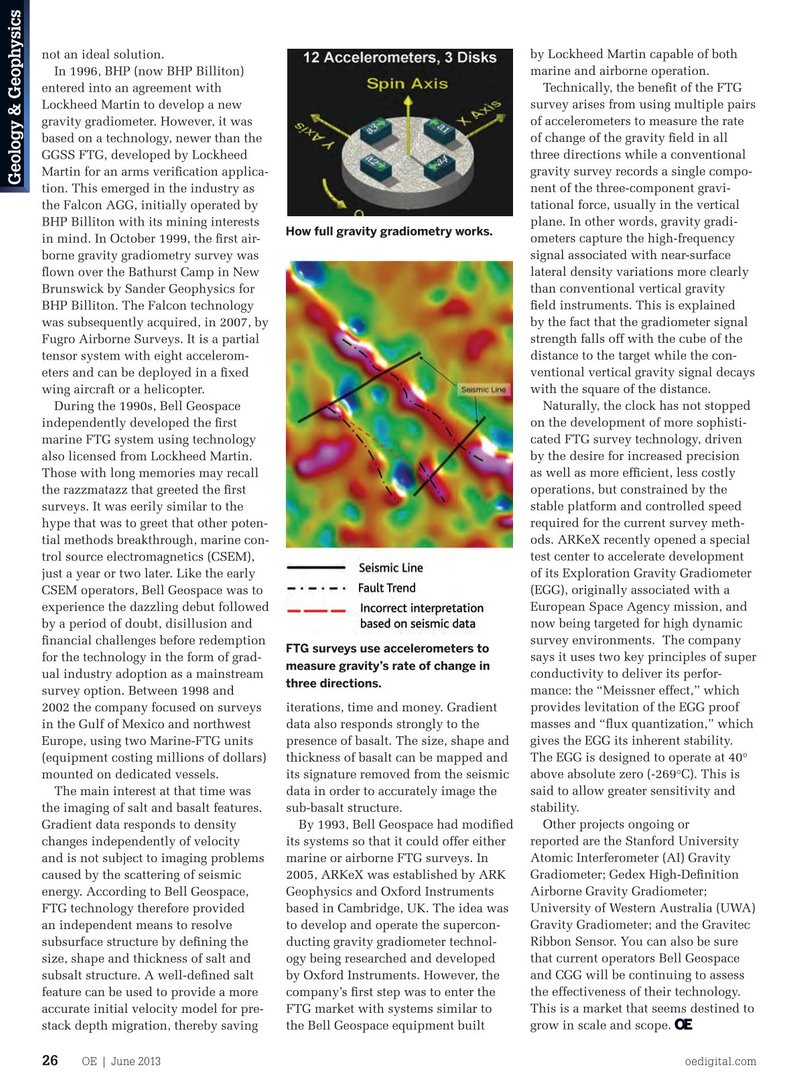
Page 24: of Offshore Engineer Magazine (Jun/Jul 2013)
Read this page in Pdf, Flash or Html5 edition of Jun/Jul 2013 Offshore Engineer Magazine
not an ideal solution. by Lockheed Martin capable of both
In 1996, BHP (now BHP Billiton) marine and airborne operation.
entered into an agreement with Technically, the beneft of the FTG
Lockheed Martin to develop a new survey arises from using multiple pairs gravity gradiometer. However, it was of accelerometers to measure the rate based on a technology, newer than the of change of the gravity feld in all
GGSS FTG, developed by Lockheed three directions while a conventional
Martin for an arms verifcation applica- gravity survey records a single compo-
Geology & Geophysics tion. This emerged in the industry as nent of the three-component gravi- the Falcon AGG, initially operated by tational force, usually in the vertical
BHP Billiton with its mining interests plane. In other words, gravity gradi-
How full gravity gradiometry works.
in mind. In October 1999, the frst air- ometers capture the high-frequency borne gravity gradiometry survey was signal associated with near-surface fown over the Bathurst Camp in New lateral density variations more clearly
Brunswick by Sander Geophysics for than conventional vertical gravity
BHP Billiton. The Falcon technology feld instruments. This is explained was subsequently acquired, in 2007, by by the fact that the gradiometer signal
Fugro Airborne Surveys. It is a partial strength falls off with the cube of the tensor system with eight accelerom- distance to the target while the con- eters and can be deployed in a fxed ventional vertical gravity signal decays wing aircraft or a helicopter. with the square of the distance.
During the 1990s, Bell Geospace Naturally, the clock has not stopped independently developed the frst on the development of more sophisti- marine FTG system using technology cated FTG survey technology, driven also licensed from Lockheed Martin. by the desire for increased precision
Those with long memories may recall as well as more effcient, less costly the razzmatazz that greeted the frst operations, but constrained by the surveys. It was eerily similar to the stable platform and controlled speed hype that was to greet that other poten- required for the current survey meth- tial methods breakthrough, marine con- ods. ARKeX recently opened a special trol source electromagnetics (CSEM), test center to accelerate development just a year or two later. Like the early of its Exploration Gravity Gradiometer
CSEM operators, Bell Geospace was to (EGG), originally associated with a experience the dazzling debut followed European Space Agency mission, and by a period of doubt, disillusion and now being targeted for high dynamic fnancial challenges before redemption survey environments. The company
FTG surveys use accelerometers to for the technology in the form of grad- says it uses two key principles of super measure gravity’s rate of change in ual industry adoption as a mainstream conductivity to deliver its perfor- three directions.
survey option. Between 1998 and mance: the “Meissner effect,” which 2002 the company focused on surveys iterations, time and money. Gradient provides levitation of the EGG proof in the Gulf of Mexico and northwest data also responds strongly to the masses and “fux quantization,” which
Europe, using two Marine-FTG units presence of basalt. The size, shape and gives the EGG its inherent stability. (equipment costing millions of dollars) thickness of basalt can be mapped and The EGG is designed to operate at 40° mounted on dedicated vessels. its signature removed from the seismic above absolute zero (-269°C). This is
The main interest at that time was data in order to accurately image the said to allow greater sensitivity and the imaging of salt and basalt features. sub-basalt structure. stability.
Gradient data responds to density By 1993, Bell Geospace had modifed Other projects ongoing or changes independently of velocity its systems so that it could offer either reported are the Stanford University and is not subject to imaging problems marine or airborne FTG surveys. In Atomic Interferometer (AI) Gravity caused by the scattering of seismic 2005, ARKeX was established by ARK Gradiometer; Gedex High-Defnition energy. According to Bell Geospace, Geophysics and Oxford Instruments Airborne Gravity Gradiometer;
FTG technology therefore provided based in Cambridge, UK. The idea was University of Western Australia (UWA) an independent means to resolve to develop and operate the supercon- Gravity Gradiometer; and the Gravitec subsurface structure by defning the ducting gravity gradiometer technol- Ribbon Sensor. You can also be sure size, shape and thickness of salt and ogy being researched and developed that current operators Bell Geospace subsalt structure. A well-defned salt by Oxford Instruments. However, the and CGG will be continuing to assess feature can be used to provide a more company’s frst step was to enter the the effectiveness of their technology. accurate initial velocity model for pre- FTG market with systems similar to This is a market that seems destined to stack depth migration, thereby saving the Bell Geospace equipment built grow in scale and scope.
OE | June 2013 oedigital.com 26 024OE_0613_gg.indd 26 5/25/13 12:25 AM

 23
23

 25
25